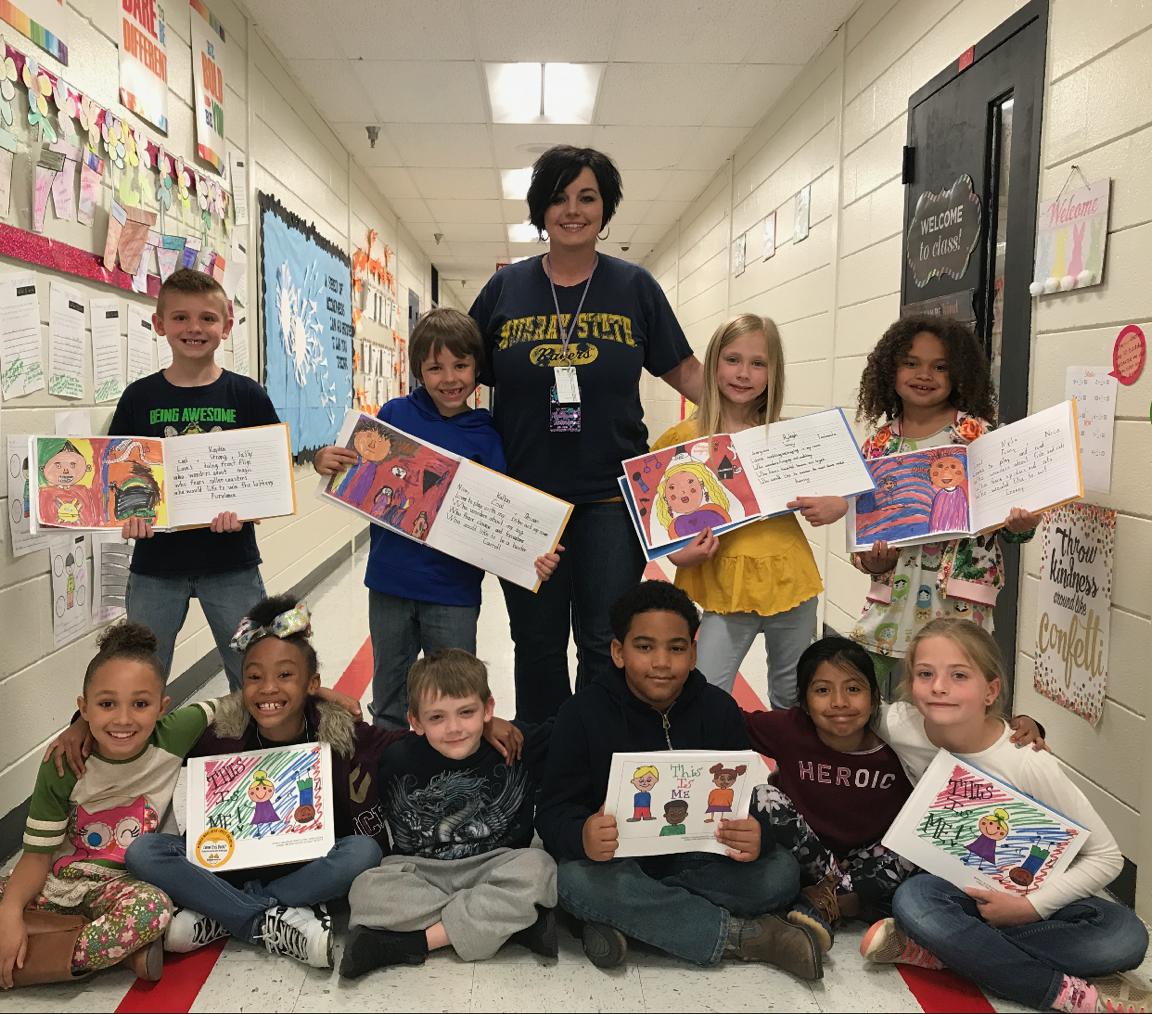
Have you been contemplating the idea of creating a classbook with your students but are unsure of where to start? Are you worried about keeping your students on track and keeping them excited about the project? Want to get your students’ parents involved in the project? Not to worry.
At Studentreasures, it’s our goal to make sure the process of creating your classbook is as easy as it possibly can be, and with help from this guide, you can ensure that your students will be looking forward to each step of this project.
TABLE OF CONTENTS
- How to make a classbook project fun and engaging
- Tips to help your students make the most out of the writing process
- Increasing parent involvement in the classbook journey
Thankfully, the first step is an easy one. All you have to do is order your free classbook publishing kit from Studentreasures. The materials in your kit will include the following.
- A FREE hardcover copy of your classbook for the teacher and an option for parents to purchase copies too
- 66 Kit Pages: 33 for Text & 33 for Illustration
- Cover, Title, Dedication and Author Page
- A Student-Created Sample Book
- Step-by-Step Teacher Guide
- Parent Order Forms
Additionally, you can utilize our teacher guides, online storyboards, lesson plans, replacement pages and sample book ideas to help your students organize their ideas and learn more about the writing process! These resources are all extremely useful when getting started. Check out these additional tips to help you keep everyone on the same page!
How to make a classbook project fun and keep all your students on track
The following strategies will help you keep your students engaged in and excited about the classbook creation process:
- Agree on a book topic as a class
- Set aside time to work on your classbook
- Encourage your students to discuss their ideas with a partner
- Make sure all of your students finish their pages on time
- Throw a party to celebrate
Agree on a book topic as a class
Getting a group of students to agree on something doesn’t have to be challenging! When creating a classbook, you’ll want to put in forth the effort to pick a topic everyone will be excited about and proud of. Here are a couple of different methods you use for a productive brainstorming session.
Class discussion
This is a laid-back way to brainstorm and is best utilized with 3rd, 4th and 5th graders or small class sizes for lower grade levels. You can show students a few classbook ideas for inspiration before you get started.
During the book topic discussion, students may raise their hands one at a time and share their ideas. Be sure to write down all of the topic ideas and make sure your students are respectful of one another and their ideas. You can also have students discuss topics within a small group and then share two or three of their ideas with the class.
For more detailed tips on how to keep class discussions and brainstorming sessions productive, check out our blog post on topic ideation for elementary students.

Classroom poll
For classes that have a difficult time taking turns speaking, have everyone write down their ideas and turn them in. You can then take all of the ideas and group similar ones together. Write these ideas down on the board and have your students put their heads down and raise their hands to vote for the topics they like. Continue to vote until you have three to four ideas left on the board.
You can now open these ideas up for discussion. Students can share creative opinions or maybe even integrate and combine some of the topics to create a new, unique idea. You know your class best. Come up with a brainstorming idea that will allow everyone to feel included and make sure everyone’s voice is heard.
Set aside time to work on your classbook
Time can get away from you quickly in the classroom, especially when students are excited about the project at hand. Research shows that students experience improved learning and produce higher quality work when designated time is set aside for them to fully engage in their work.
To accomplish this, set a time limit each day that is dedicated to working on the classbook pages and stick to it. Limit distractions by scheduling classbook work time during a period with minimal distractions. Ideally, this is a time where there isn’t likely to be a lot of interruptions, such as announcements or visitors. We also suggest that you not schedule this work time right before or after recess.
Allow your students to move around the room and work on their classbook pages in different areas. We’ve found that limiting students to working at their desks can sometimes cause them to lose interest in the project at hand.
Encourage your students to discuss their ideas with a partner
Some of your students may have a difficult time developing their story and could benefit from another perspective on their ideas. It’s important to give your students what they need to complete their stories and encourage them to ask for help when they need it.
Let them work with a peer to help them gain confidence, find inspiration and move forward with their ideas. They may even find a unique direction to take with their original idea. Discussing ideas and challenges with a partner shows young students the importance of collaboration. It also emphasizes that asking for help is a valid strategy and should not be looked down upon.
Make sure all of your students finish their book pages on time
It’s time to start teaching your students about deadlines! They will thank you for this as they progress further into their educational careers and their professional lives as well.
Set mini-deadlines or “goals” to help students complete their classbook pages on time. For example, “We all will need to have our first drafts written by Friday.” Be sure to communicate clearly with your students about what the expectations are and give them plenty of reminders.
Some students may struggle with certain aspects of the writing process, making it more difficult for them to complete things on time. You can either give these students a little extra attention or have them partner up with another student who is more skilled at the writing process. Once all of your students’ classbook pages are complete, send everything to us, and your classbook will be published into a one-of-a-kind book!

Throw a party to celebrate
If you make it to this step, that means you’ve officially reached your goal. It’s time to celebrate! Your students are now officially published authors! Show them how important this accomplishment is by throwing a classroom party.
You can make it as simple or as elaborate as you want. Just make sure that you mention it throughout the project to keep your students’ enthusiasm high. Whether you have a pizza party for the class or allow students to bring in treats and snacks to share, just be sure to set aside some time to let them soak in this milestone. You can unveil the books and allow students to read and discuss them.
If you had a unique theme for your book, it could be fun to incorporate that into the party theme with costumes or decor. You can also have a book signing with students from the other classrooms or have your students sign autographs for each other and read their classbook page. However you choose to go about it, just make sure your students feel special. This is a huge accomplishment!
Are you Enjoying this Content?
Tips to help your students make the most out of the writing process
Helping young writers become published authors is both a privilege and a thrill. There’s nothing we love more than watching their faces light up when they open a box full of brand new books with their names on the About the Authors page.
As their teacher, it’s up to you to inspire your elementary students to do their best. Teaching them how to write and publish their work is a major part of this process, and your kids will need support and encouragement every step of the way.
Sharing the following tips with your soon-to-be authors will help them write more effectively and get the most out of their classbook project, not to mention future writing projects!
Tip #1… the first rule of brainstorming is “don’t hold back”
Brainstorming is one of the most exciting parts of the writing process, but there’s no denying that it can be a bit challenging. It’s easy to get stuck on one idea, or worse, get stuck with no ideas at all! It happens to professional writers all the time.
Remind them that when it comes to brainstorming, there are no wrong answers. Sometimes you have to come up with a few bad ideas before you can get to the really good ones. Encourage your students to think outside of the box (way outside the box if they have to) and let their imaginations run wild.
Tip #2… it’s okay to make mistakes
Especially for young, inexperienced writers, first draft doubts can make even the most confident students hesitate. Blank pages are intimidating, and it’s hard to turn off your inner critic, especially when you haven’t had much practice at it yet.
Remind your students that first drafts aren’t meant to be perfect. Even the most talented storytellers have to rewrite their work, sometimes more than once! That’s why your students get practice pages to work on first, and free replacement materials are always available if they need a little extra practice.
Tip #3… editing someone else’s work is about helping not criticizing
When teaching your students to edit one another’s work, make sure you take time to discuss their editing goals. It’s important that they know that they’re not just looking for mistakes to correct. Their aim should be to help a fellow writer learn and grow.
Encourage your students to include at least one or two positive notes whenever they give feedback and focus on offering ideas on how the other person can improve their writing, as opposed to outright criticizing it. Criticism should be constructive, not mean.
Tip #4… self-edit one word at a time
When editing, it’s easy to overlook the little things, especially when your students are proofreading their own work. Be sure to emphasize the importance of taking the time to do it right and reading over each and every sentence. After all, their work is going to be published and once that’s done, it can’t be undone!
It’s up to them to make sure their work is the best it possibly can be, something they can be truly proud to share with others. The more effort they put into editing and revising their work now, the brighter it will shine when it’s displayed on a bookshelf!
Increasing parent involvement in the classbook journey
One of the many great things about classbook projects is the way it increases parent involvement in your students’ education. How? Seeing their children’s work in print is the perfect way to strengthen parental interest in classroom goings-on. After all, just as their kids will become proud authors by the end of the project, they will become the proud parents of published authors.

Time and time again, research has shown that parent involvement plays a major role over the course of a child’s education. As a report by SEDL (the Southwest Educational Development Laboratory) states, “When schools, families, and community groups work together to support learning, children tend to do better in school, stay in school longer, and like school more.” As teachers, we witness the proof of this every day. The more support a child has on their academic journey, the brighter their future is.
But for busier moms and dads, prioritizing active involvement in school can be tough, which is why we teachers work so hard to remind them of the crucial role they play in their child’s education. If you want to encourage your students’ parents to participate in your classbook project, try one (or more) of the following approaches.
Assign family interviews
One incredibly fun and engaging way to get parents more involved in school is to use their knowledge and experiences as a source of inspiration for your students’ classbook projects.
Choose a topic that requires an at-home interview between your students and their parents, such as the question “what was life like when you were my age?” For younger students, a single question will do, while you may ask more experienced writers to create a short list of questions for their interviews.
The great thing about assigning an interview as homework is that it doesn’t just get parents more involved in your project, it also encourages your students to communicate more openly with their parents. Plus, the book itself will be that much more precious of a keepsake for having that extra personal touch.
PROJECT IDEA
Instead of researching and writing a biography about some old, well-known historical figure, why not have your students practice their nonfiction writing skills on a more personal level? Have them interview their parents about their life experiences and write short biographies based on their interviews.
Then, ask them to draw their parents at different stages of life, as children, as teenagers, and as adults. Publish their work as a unique collection of never-before-seen biographies that will make their parents proud!
Host a parent expo
An even more direct way to get parents involved in your school is to invite them to come and speak to your class about a topic of interest, both to them and to their kids. This can be anything from their careers to their hobbies to sharing funny or inspiring stories that will spark their children’s curiosity and creativity. It lets parents know that you and your students value their input and makes for quite the memorable get-together!
PROJECT IDEA
Considering a classbook topic about finding a passion or landing a dream job? Try hosting a classroom career day! Invite parents to come in and speak to your students about their jobs, including what it took to get where they are and what it’s like to do what they do.
Your students can use their presentations as inspiration for their own research and writing, or you can ask each student to profile one of the careers represented and then publish a career-catalog-style classbook that your students can look to for information and inspiration.
Celebrate together
The moment your students’ books arrive and they officially become published authors is unforgettable. Inviting parents to participate in a post-publishing celebration or launch party allows them to share this special moment with their children.
You might want to go all-out and plan a full-blown publishing party, complete with amusing parent-child activities and events, or if the sound of a big bash leaves you feeling a bit overwhelmed, there are always other options. Celebrating your students’ writing can be as simple as inviting parents to join your class one day for a small box-opening ceremony or a live reading session.
PROJECT IDEA
For a really unique publishing party experience, combine this idea with the family interviews project by having your students interview their parents about a happy memory from when they were in elementary school.
Ask your students to then write a short story about that memory in the first person, as if they are experiencing it as their parent did. After publishing your classbook, invite parents to your class to listen to their child read his or her page aloud.
Creating the writers of tomorrow
For more than twenty-five years, Studentreasures has been providing free tools for nurturing and developing the authors of tomorrow. Our goal is for every child to experience the joy that comes from becoming a published author, build their confidence as creative writers and see their hard work come to life in a professionally bound book.
Order your free classbook publishing kit today or head over to our Teacher’s Lounge for helpful resources to further inspire and guide your students along the publishing journey.






